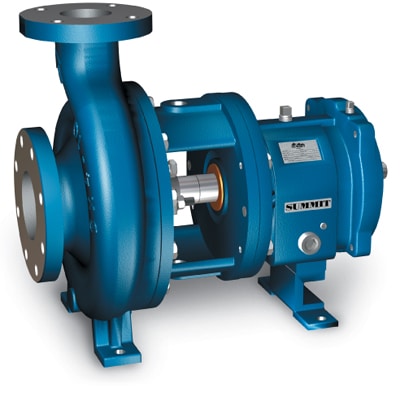How Does a Centrifugal Pump Work?
Centrifugal pumps are a broad category of pumps that vary in ability, capacity, and size. You’ll find several different centrifugal pumps, which may be suitable for various applications. Here is what you need to know about these pumps, how they work, and what limitations they might have so that you can choose the right one for your needs.
 What Is a Centrifugal Pump?
What Is a Centrifugal Pump?
A centrifugal pump is a mechanical device that transfers fluid using energy produced by powered rotors. The fluid enters a fast-rotating rotor, called an impeller, and is pushed out by centrifugal force in the desired direction. The action of the pump can also change the velocity of the fluid, giving the operator some control over the flow of fluid. Some of the advantages of centrifugal pumps include:
- They are small in size and can fit into tight spaces.
- The pump provides a continuous flow rate.
- The pump is very efficient for high head and low-flow operations.
- The pump is excellent for high-temperature and high-pressure fluids.
How Does a Centrifugal Pump Work?
The main component of a centrifugal is its impeller. This part consists of several curved fans, which may or may not be surrounded by two discs – an enclosed impeller vs. an open impeller.
The fluid being moved will enter the impeller at the center and exit along the fans or the impeller’s vanes. The impeller is anchored to the pump using a drive shaft powered by the pump’s motor.
The centrifugal pump motor can rotate the impeller at a high rate of speed, typically from 500 to 5000rpm. This fast rotation forces the fluid through the impeller’s fans and into the pump’s casing. A centrifugal pump’s casing can have two types of designs – volute or diffuser. Both types of design create enough pressure to allow for a controlled transfer of fluid. The impeller is offset when a volute casing is used.
This creates a curve-shaped outlet, causing the pressure of the fluid to increase as it moves through the chamber. In a diffuser design, the impeller is set into the center. As the pressure increases, fluid is pushed outward in every direction and eventually reaches a discharge port.
Main Features of Centrifugal Pumps
Here are a few of the main features of centrifugal pumps:
- Throttling flowrates
- Head-flow curves
- Viscosity
- Horsepower
Throttling Flowrates
One advantage of centrifugal pumps is their ability to vary flow rates over a wide range. Of course, there will be a minimum and maximum safe flow rate for these pumps and the best efficiency point (BEP). Running outside these parameters could damage the pump or reduce its useful life.
Head-Flow Curves
Most centrifugal pumps provide their “Head-Flow” Curves, which is a chart that tells you how many gallons per minute of flow you can achieve a particular speed or power.
Viscosity
Centrifugal pumps are designed to work with liquids with a relatively low viscosity. The parameters for one pump will vary from another, but these pumps tend to get inefficient as pumps exceed those of 30 wt oils.
Horsepower
Centrifugal pumps require higher horsepower motors to move non-viscous liquids that are denser than water, such as many chemicals and fertilizers.
Primary Applications for Centrifugal Pumps
Centrifugal pumps are used for various purposes, such as pumping water, oils, solvents, organics, bases, acids, and any other “thin” liquids in agricultural, industrial, and domestic applications. Here are just a few examples of centrifugal pumps and their uses:
- Circulator pump – used in air conditioning, heating, and ventilation
- Canned motor pump – used with chemicals where leakage isn’t an option
- Multistage pump – used for high-pressure applications
- Grinder/chopper pump – used in food processing, sewage, chemical, and wastewater applications
- Trash pump – used in pits, construction sites, and draining mines
- Cryogenic pump – used for coolants and liquid natural gas applications
Do Centrifugal Pumps Have Any Limitations?
Centrifugal pumps have a lot of useful features and are used for many common applications. However, they do have a few limitations. Centrifugal pumps require high-speed, constant impeller rotation to operate at their highest efficiency. When the liquid has a high viscosity, a centrifugal pump can become inefficient because there tends to be more resistance as you increase the pressure in the pump to maintain the required flow rate.
Because of their limitations, centrifugal pumps are best suited for high-capacity, low-pressure applications that move liquids with viscosities from 0.1 to 200 cP. Slurries like high-viscosity oils and mud can cause overheating or excessive wear on a centrifugal pump, eventually leading to damage and failure. A pump that is less prone to these issues is a positive displacement pump.
One other limitation of centrifugal pumps is that they cannot operate when dry. In other words, these pumps must be primed with the fluid being transferred. Therefore, a centrifugal isn’t a good option for an application in which its use will be intermittent or the pressure delivered is variable.
C&B Equipment Sells and Services Centrifugal Pumps
If your business needs to purchase a centrifugal pump or service for an existing pump, C&B Equipment would love to earn your business.
We are an industrial distribution and service company that focuses on helping clients increase uptime with the most efficient and reliable solutions. We carry a full line of centrifugal pumps and help clients with maintenance, service, and repair.
Contact us today to find out more about how we can help your business improve its results with our various solutions.
